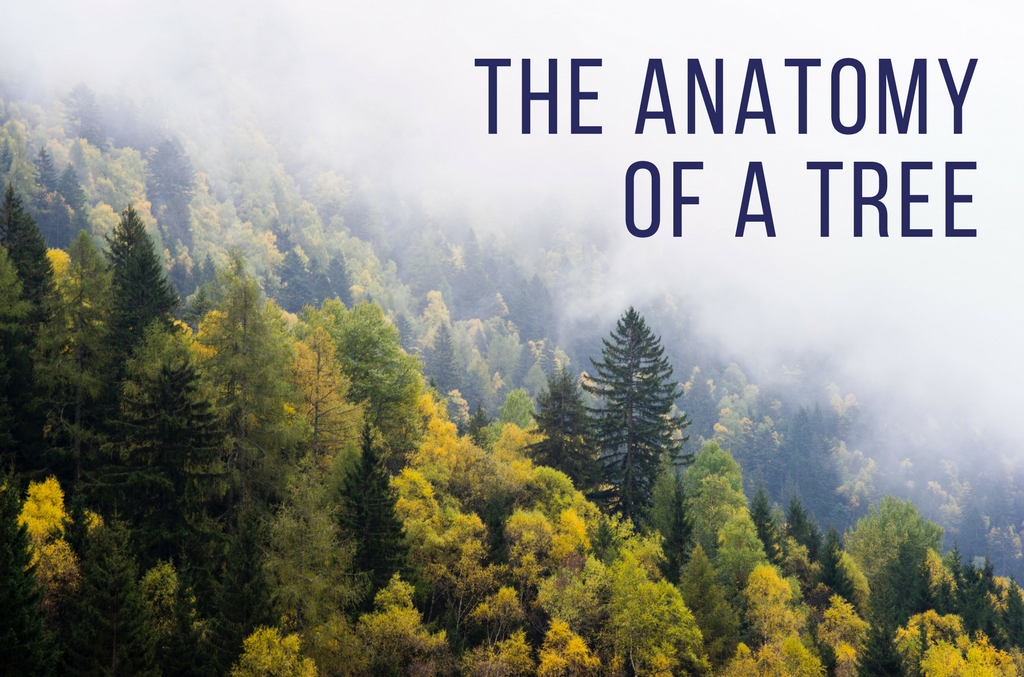There is more than meets the eye when it comes to trees, they are far more than just bark, branches and leaves. Like humans there is an entire anatomical system within all trees. So whether you’ve always wondered or haven’t ever really thought about it, let us enlighten you on the anatomy of a tree!
Starting from the top down we have…

The Leaves
One of the many elements that makes trees beautiful. They provide us with shade and if you’re lucky enough to live in a proper area, can be bursting with color during this time of the year. The main function of the leaf is to carry out photosynthesis. This means the leaves are responsible for making food for the tree and releasing oxygen into the air. It’s because of this job that determines their shapes. For example, trees with larger leaves are more able to reduce wind resistance, evaporate the water used in food-building and provide “drip tips” to shed the rain that could damage the leaf if it was left standing.

Branches and Twigs
Branches and twigs serve as the transportation system for the tree. For an analogy: if the subway uses underground tunnels to transport people through out New York, think of the branches and twigs as the “tunnels” that transports the materials (the “people”) from leaves to the trunk and vise-versa. Growing out of the trunk they also support leaves, flowers and fruit.

The Trunk
Perhaps this is the most complex part of the tree. The trunk is more than a chunk of wood, in fact there are several layers to a trunk, each with a different function.
- Outer Bark: The tree’s shield to the outside world. The outer bark helps keep out moisture in the rain while also helping the tree retain moisture when it is dry outside. It’s also able to insulate a tree in all sorts of weather and guard against unwanted insects. The outer bark is a continual system, constantly renewed from within.
- Inner Bark (phloem): This is the pipeline in which food is passed to the rest of the tree. The lifespan of the phloem is short. Once it dies it becomes cork and becomes park of the outer bark.
- Cambium Cell Layer: This part of the tree is always growing. Annually, it produces new bark from the hormones that are passed through the phloem with the food from the leaves. The hormones are called auxins and stimulate growth within the cells. Once they start growing in the spring, auxins are produced by leaf buds at the ends of branches.
- Sapwood: This is the water pipeline. The Sapwood is responsible for getting water to the leaves of the tree. Sapwood is new wood and as newer rings are laid, the inner cells die and become Heartwood.
- Heartwood: This is the innermost part of the trunk. Although the Heartwood is dead, it is the support for the tree. It does not decay or loose strength as long as the outer layers are intact. The Heartwood is composed of hollow, needle-like cellulose fibers. The fibers are held together by a “chemical glue” called lignin, which is incredibly strong.
The Roots
When people think of tree roots their minds often wander deep beneath the soil to a weblike image of sprawling roots. This is actually only partly true. While the roots of a tree do often sprawl out two to four times the span of the tree crown, they are really only found within the top three feet of soil. The function of the roots are to absorb water and minerals from the soil for the rest of the tree. They also serve as an anchor for the tree to the ground and store up food reserves for the winter. There are two types of tree roots: large perennial roots and smaller, short-lived feeder roots.


